Ignacy Jan Paderewski
| Ignacy Jan Paderewski | |
|---|---|
|
Paderewski circa 1935 | |
| 3rd Prime Minister of Poland 2nd Prime Minister of the Republic of Poland | |
|
In office 18 January 1919 – 27 November 1919 | |
| Preceded by | Jędrzej Moraczewski |
| Succeeded by | Leopold Skulski |
| Minister of Foreign Affairs | |
|
In office 16 January 1919 – 9 December 1919 | |
| Preceded by | Leon Wasilewski |
| Succeeded by | Władysław Wróblewski |
| Chief of the National Council of Poland | |
|
In office 9 December 1939 – 29 June 1941 | |
| Personal details | |
| Born |
6 November 1860 Kuryłówka, Podolia |
| Died |
29 June 1941 (aged 80) New York City, U.S. |
| Profession | pianist, composer, politician |
| Signature |
|
Ignacy Jan Paderewski (Polish: [iɡˈnatsɨ ˈjan padɛˈrɛfskʲi]; 18 November [O.S. 6 November] 1860 – 29 June 1941) was a Polish pianist and composer, politician, statesman and spokesman for Polish independence.[1] He was a favorite of concert audiences around the world. His musical fame opened access to diplomacy and the media.
Paderewski played an important role in meeting with President Woodrow Wilson and obtaining the explicit inclusion of independent Poland as point 13 in Wilson's peace terms in 1918, called the Fourteen Points.[2] He was the Prime Minister of Poland and also Poland's foreign minister in 1919, and represented Poland at the Paris Peace Conference in 1919. He served 10 months as prime minister, and soon thereafter left Poland, never to return.[3]
Early life and education
Paderewski was born to Polish parents in the village of Kuryłówka (Kurilivka), Litin uyezd in the Podolia Governorate of the Russian Empire, which had been part of the greater Polish empire for centuries. The village today is part of the Khmilnyk raion of Vinnytsia Oblast in Ukraine. His father, Jan Paderewski, was an administrator of large estates. His mother, Poliksena, née Nowicka, died several months after Paderewski was born, and he was brought up by distant relatives.
.jpg)
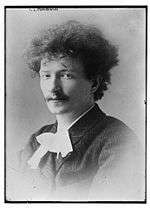
From his early childhood, Paderewski was interested in music while living at the private estate near Żytomir, where he moved with his father. However, soon after his father's arrest in connection with the January Uprising (1863), he was adopted by his aunt. After being released, Paderewski's father married again and moved to the town of Sudylkov, near Shepetovka.
Initially, he took piano lessons with a private tutor. At the age of 12, in 1872, he went to Warsaw and was admitted to the Warsaw Conservatory. After graduating in 1878, he was asked to become a tutor of piano classes at his alma mater, a position he accepted. In 1880, Paderewski married a fellow student at the conservatory Antonina Korsakówna. The following year, their son was born severely handicapped; Antonina never recovered from childbirth and died several weeks later. Paderewski decided to devote himself to music; he left his son in the care of friends, and in 1881 went to Berlin to study music composition with Friedrich Kiel[4] and Heinrich Urban. A chance meeting in 1884 with a famous Polish actress, Helena Modrzejewska, set him on a course of a career as a virtuoso pianist. Modrzejewska arranged for a public concert and appearance together in Kraków's hotel Saski to raise funds for Paderewski's further piano study. The scheme was a tremendous success and he moved to Vienna, where he became a pupil of the preeminent pedagogue of Polish descent, Theodor Leschetizky (Teodor Leszetycki).
Pianist, composer, and supporter of new composers
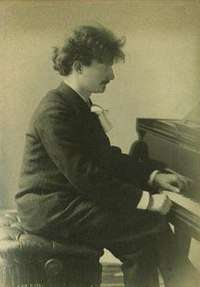
After three years of diligent study and a teaching appointment in Strasbourg arranged for by Leschetizky, Paderewski made his concert debut in Vienna in 1887. He soon gained great popularity and his subsequent appearances (in Paris in 1889 and in London in 1890) were major successes. His brilliant playing created a furor that reached to almost extravagant lengths of admiration. A large part of his great success stemmed from his stage presence and his striking looks. Paderewski had immense charisma, which would prove equally important in his political and charitable activities. In 1891 the pianist set for a tour of the United States, which brought him great acclaim and fortune as well as access to the halls of power. His name at once became synonymous with the highest level of piano virtuosity. Not everyone was equally impressed, however. After hearing Paderewski for the first time, Moriz Rosenthal said: "Yes, he plays well, I suppose, but he's no Paderewski".[5] America became the place he toured most often (over 30 times in 50 years) and his second home.
Paderewski kept up a furious pace of touring and composition, including many of his own pieces for piano in his concerts. He also wrote an opera, Manru, which to date has been the only opera by a Polish composer ever performed in the Metropolitan Opera's 135-year history. A “lyric drama,” Manru is an ambitious work formally inspired by Wagner’s music dramas; it lacks an overture and closed-form arias, rather employing Wagner’s device of leitmotifs to represent characters and ideas. The story centers on a doomed love triangle, social inequality and racial prejudice (Manru is a Gypsy) and is set in the Tatra Mountains. In addition to the Met, Manru was staged in Dresden (in a private royal viewing), Lviv (its official premiere in 1901), Prague, Cologne, Zurich, Warsaw, Philadelphia, Boston, Chicago, Pittsburgh and Baltimore, Moscow, and Kiev. In 1904, Paderewski, his second wife, entourage, parrot, and Erard piano gave concerts in Australia and New Zealand, in collaboration with Polish-French composer, Henri Kowalski.[6] Paderewski toured tirelessly around the world, he pioneered the format of the solo recital as most public concerts at the time featured multiple artists in the interest of variety; he was the first to give a solo performance at the new 3,000-seat Carnegie Hall. In 1909 came the premiere of his Symphony in B minor "Polonie", a massive work lasting 75 minutes. Paderewski’s compositions were quite popular during his lifetime and for a time entered the orchestral repertoire, in particular his Fantaisie polonaise sur des thèmes originaux (Polish Fantasy on original themes) for piano and orchestra, piano Concerto in A minor, and Polonie symphony. His piano miniatures became especially popular; the Minuet in G major, Op. 14 No. 1 written in the style of Mozart became one of the most recognized piano tunes of all time. And even though his relentless touring schedule and his increasingly more valuable and urgent political and charitable engagements imposed on his composition, Paderewski left a legacy of over 70 orchestral, instrumental and vocal works.

In 1896, Paderewski donated US$10,000 to establish a trust fund to encourage American-born composers. The fund underwrote a triennial competition that began in 1901 called the Paderewski Prize. Paderewski also launched a similar contest in Leipzig in 1898. He was extremely popular internationally, to such an extent that the music hall duo "The Two Bobs" had a hit song in 1916, in music halls across Britain, with the song "When Paderewski Plays". He was a favorite of concert audiences around the globe; women especially admired his performances.[7]
Philanthropy
By the turn of the century, the artist was an extremely wealthy man generously donating to numerous causes and charities, he also sponsored the building of monuments, among them the Washington Arch in New York in 1892. He shared his fortune generously with fellow countrymen, as well as with citizens of many other countries around the world. He provided for many funds and foundations. Among them were: the foundation for young American musicians and for the students of Stanford University (1896), the fund in aid of the Treasury of the Professor of the Parisian Conservatory (1909), the scholarship fund for Ecole Normale (1924), for the students of Moscow Conservatory and Petersburg Conservatory (1899), the funds for the spas in the Alps (1928), for the British Legion. Paderewski generously supported the unemployed (e.g. in Switzerland in 1937) and unemployed musicians in the United States (1932). He also came out in support of the insurance fund for musicians in London (1933) and in aid of Jewish intellectuals (Paris, 1933). He financially supported orphanages and the Maternity Centre in New York. Many concert halls and monuments were built with the artist`s financial participation. Among the Paderewski-sponsored monuments were: Debussy (1931) and Colonne (1923) monuments in Paris, Liszt Monument in Weimar, Beethoven Monument in Bonn, Chopin Monument in Zelazowa Wola, the composer's birthplace, Kosciuszko Monument in Chicago, Washington Arch in New York, and many, many others.
California
In 1899, he married his second wife, Baroness de Rosen (1856–1934). In 1913, Paderewski settled in the United States. On the eve of World War I, and at the height of his fame, Paderewski bought a 2,000-acre (810-ha) property, Rancho San Ignacio, near Paso Robles, in San Luis Obispo County, in the Central Coast area of California. A decade later he planted Zinfandel vines on the California property. When the vines matured, the wine was made for him at the nearby York Mountain Winery, then, as now, one of the best-known wineries between Los Angeles and San Francisco.[8]
Politician and diplomat
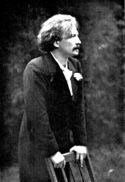
In 1910, he funded the erection of the Battle of Grunwald Monument in Kraków, in commemoration of the 500th anniversary of the event. Unveiling of the monument became the occasion of a great patriotic demonstration. Paderewski spoke to the gathered masses and proved to be as adept at capturing their hearts and minds with his oratory for a political cause as he was with his music. He was a great speechmaker with a passionate delivery and no recourse to notes. The fact that he was an artist and a philanthropist and not a member of any of the Polish political factions fighting for influence over the movement, was one of his greatest assets; he rose above the quarrels, he could legitimately appeal to higher ideals of unity, sacrifice, charity, and work for common goals.
During World War I, Paderewski became an active member of the Polish National Committee in Paris, which was soon accepted by the Entente as the representative of the forces trying to create the state of Poland. He became a spokesman of that organization, and soon also formed other social and political organizations, among them the Polish Relief Fund, in London. It was then that he met the English composer Edward Elgar, who used a theme from Paderewski's Fantasie Polonaise[9] in his work Polonia written for the Polish Relief Fund concert in London on 6 July 1916 (the title no doubt recognizing Paderewski's Symphony in B minor).
He agitated among immigrants to join the Polish armed forces in France, and he pressed elbows with all the dignitaries and influential men whose salons he could enter. He spoke to Americans directly in public speeches and on the radio, appealing to them to remember the fate of his nation. He kept such a demanding schedule of public appearances, fundraisers and meetings that he stopped touring altogether for a few years dedicating himself to diplomatic activity exclusively. On the eve of the U.S. entry into the war, in January 1917, President Woodrow Wilson’s advisor, Colonel House, turned to Paderewski to prepare a memorandum on the Polish issue. Two weeks later, Wilson spoke before Congress and issued a challenge to the status quo, “I take it for granted,” he said, “that statesmen everywhere are agreed that there should be a united, independent, autonomous Poland." The establishment of "New Poland" became one of Wilson’s famous Fourteen Points.[2] – principles of peace negotiations to end World War I. In April 1918, he met in New York City with leaders of the American Jewish Committee in an unsuccessful attempt to broker a deal whereby organized Jewish groups would support Polish territorial ambitions in exchange for support for equal rights. However, it soon became clear that no plan would satisfy both Jewish leaders and Roman Dmowski, head of the Polish National Committee, who was strongly anti-semitic.[10]
At the end of the war, with the fate of the city of Poznań and the whole region of Greater Poland (Wielkopolska) still undecided, Paderewski visited Poznań. With his public speech on 27 December 1918, the Polish inhabitants of Poznań began a military uprising against Germany, called the Greater Poland Uprising. He worked hard to get Dmowski and Józef Piłsudski to collaborate, but Piłsudski won out.

In 1919, in the newly-independent Poland, Piłsudski, who was the Chief of State, appointed Paderewski as the Prime Minister and Minister of Foreign Affairs (January 1919 – December 1919). He and Dmowski represented Poland at the 1919 Paris Peace Conference, dealing with issues regarding territorial claims and minority rights.[11] Paderewski at the time tried to somehow whitewash to the press the role of the recreated Polish Army in the Jewish pogroms happening at the time in the Polish–Soviet War.[12][12] He signed the Treaty of Versailles, which restored the territories of Greater Poland and Pomerania around the City of Gdańsk to Poland. Although this fell short of what the Polish delegates had demanded, these territories provided the core of the restored Polish state.
Paderewski’s government achieved remarkable milestones in just ten months: democratic elections to Parliament, ratification of the Versailles Treaty, passage of the treaty on protection of ethnic minorities in the new state, establishment of a public education system; it tackled border disputes, unemployment, ethnic and social strife, the outbreak of epidemics and it averted looming famine after the devastation of war. After the elections, Paderewski resigned his Prime Minister’s post, however, he continued to represent Poland abroad at international conferences and at the League of Nations. Thanks to his diplomatic skills – he was the only delegate who was not assigned a translator as he was fluent in seven languages – and great personal esteem, Poland was able to negotiate thorny issues with her neighbors Ukraine and Germany and gain international respect in the process.
Return to music
In 1922 he retired from politics and returned to his musical life. His first concert after a long break, held at Carnegie Hall, was a significant success. He also filled Madison Square Garden (20,000 seats) and toured the United States in a private railway car.[13]
Soon he moved to Morges in Switzerland. After Piłsudski's coup d'état in 1926, Paderewski became an active member of the opposition to Sanacja rule. In 1936 a coalition of members of the opposition was signed in his mansion; it was nicknamed the Front Morges after the name of the village.
By 1936, two years after the death of his wife, Paderewski consented to appear in a film presenting his talent and art on the screen. This proposal had come at a time when Paderewski did not wish to appear in public. However, the film project did proceed, and the selected film script was an opportunity to feature Paderewski. The film was directed by the exiled German-born director, Lothar Mendes, released in Britain as Moonlight Sonata in 1937, retitled The Charmer for United States distribution in 1943; it is notable primarily for its rare footage of his performance on the piano.
In November 1937 Paderewski agreed to take on one last pupil for the piano. This musician was Witold Małcużyński who had won third place at the International Chopin Piano Competition.
Return to politics
After the Polish Defensive War of 1939, Paderewski returned to public life. In 1940 he became the head of the National Council of Poland, a Polish parliament in exile in London. He turned to America for help as well. He spoke to the American people directly over the radio, the most popular media at the time; the broadcast carried by over a hundred radio stations in the United States and Canada. In late 1940 he crossed the Atlantic again to advocate in person for the cause of aiding Europe and defeating Nazism. In 1941, he witnessed a touching tribute to his artistry and humanitarianism as US cities celebrated the 50th anniversary of his first American tour by putting on a Paderewski Week with over 6000 concerts in his honor. The 80-year-old artist also restarted his Polish Relief Fund and gave several concerts to gather money for it. However, his mind was not what it had once been: scheduled again to play Madison Square Garden, he refused to appear, insisting that he had already played the concert, presumably remembering the concert he had played there in the 1920s.[13]
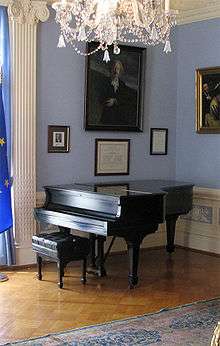
Death
Paderewski was taken ill during one such tour, on June 27, 1941. Nothing was discussed with his personal secretary or entourage, but at the initiative of Sylwin Strakacz, physicians were called in for consultation and they diagnosed pneumonia. Despite signs of improving health and recovery, Paderewski died in New York at 11:00 p.m., June 29, aged 80. He was temporarily laid in repose in the crypt of the USS Maine Mast Memorial at Arlington National Cemetery, in Arlington, Virginia, near Washington, D.C. In 1992, his body was brought to Warsaw and placed in St. John's Archcathedral. His heart is encased in a bronze sculpture in the National Shrine of Our Lady of Czestochowa near Doylestown, Pennsylvania.[15]
Early in 1941, the music publisher Boosey & Hawkes had commissioned 17 prominent composers to contribute a solo piano piece each for an album to commemorate the 50th anniversary of Paderewski's American debut in 1891. His death in June caused the album to become a posthumous tribute to his entire life and work. Homage to Paderewski was published in 1942.
Museum display
The Polish Museum of America[16] in Chicago received a donation of the personal possessions of Ignacy Jan Paderewski following his death in June 1941. Both Ignacy Paderewski and his sister, Antonina Paderewska Wilkonska were enthusiastic supporters and generous sponsors of the Museum. Antonina, executor of Ignacy’s will, decided to donate these personal possessions to the Museum, as well as artifacts from his apartment in New York. This space was officially opened on 3 November 1941.
Memorials and tributes
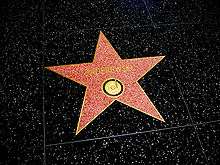
In 1948 the Ignacy Paderewski Foundation was established in New York City, on the initiative of the Polish community in New York with the goal of promoting Polish culture in the United States.[17] Two other Polish-American organizations are also named in his honor and dedicated to promoting the legacy of the maestro: the Paderewski Association in Chicago as well as the Paderewski Music Society in Southern California.
Due to the unusual combination of the notable achievements of being a world-class pianist and a successful politician, Saul Kripke used Paderewski in a famous philosophical example in his article "A Puzzle about Belief".[18] Paderewski was so famous that in the 1953 motion picture The 5,000 Fingers of Dr. T, written by Theodor Seuss Geisel, better known as Dr. Seuss, piano teacher Terwilliker tells his pupils that he will "make a Paderewski" out of them.
Two music festivals honoring Paderewski are celebrated in the United States, both in November. The first Paderewski Festival has been held each year since 1993, in Paso Robles, California. The second Paderewski Festival - Raleigh has been held since 2014 in Raleigh, North Carolina.
The facade of White Eagle Hall in Jersey City, New Jersey is adorned with busts of Polish heroes Ignacy Jan Paderewski, Casimir Pulaski, Tadeusz Kosciuszko and Henryk Sienkiewicz.[19]
Honours and awards
4-cent version
There are streets and schools named after Paderewski in many major cities in Poland. There are also streets named after him in Perth Amboy, New Jersey, and Buffalo, New York. In addition, the Academy of Music in Poznań is named after him. Paderewski has a star on the Hollywood Walk of Fame in Los Angeles, awarded in 1960.[20]
- Order of the White Eagle
- Order of Virtuti Militari, Silver Cross (posthumous)
- Order of Polonia Restituta, Grand Cross
- Legion of Honour, Grand Cross (France)
- Honorary Knight Grand Cross of the Order of the British Empire (1925)
- Honorary doctorates from universities in Lvov (1912), Kraków (1919), Poznań (1924) and Warsaw (1931), as well as several American universities.
- Honorary citizen of Warsaw
- Honorary Studentenverbindung Patria
- Academic Golden Laurel of the Polish Academy of Literature for oratory
On 8 October 1960, the United States Post Office Department released two stamps commemorating Ignacy Jan Paderewski.[21] Poland also honored him with postage stamps on at least three occasions.
Notes
- ↑ Carol R. Ember; Melvin Ember; Ian Skoggard (2005). Encyclopedia of Diasporas: Immigrant and Refugee Cultures Around the World. Springer. p. 260. ISBN 0306483211.
- 1 2 Hanna Marczewska-Zagdanska, and Janina Dorosz, "Wilson - Paderewski - Masaryk: Their Visions of Independence and Conceptions of how to Organize Europe," Acta Poloniae Historica (1996), Issue 73, pp 55-69.
- ↑ Hartman, Carl. "Paderewski Remains Begin Journey Home", Associated Press via The Daily News (26 June 1992).
- ↑ Paderewski, Ignacy Jan. Małgorzata Perkowska-Waszek, ed. "Letters of Ignacy Jan Paderewski (A Selection)" (PDF). Translated by Cara Thornton. Retrieved 11 January 2008.
- ↑ Harold C. Schonberg, The Great Pianists, p. 284.
- ↑ fr:Henri Kowalski
- ↑ Maja Trochimczyk, "An Archangel at the Piano: Paderewski's Image and His Female Audience," Polish American Studies (2010) 67#1 pp 5-44
- ↑ "Wine Talk" The New York Times, 5 July 1995
- ↑ Correspondence between Elgar and Paderewski
- ↑ Riff, 1992, 89–90
- ↑ Prazmowska, Anita (2010). Makers of the Modern World: Ignacy Paderewski, Poland. Haus Publishing Ltd. pp. 76–97. ISBN 978-1-905791-70-5.
- ↑ LEMBERG POGROMS WERE NOT BY POLES - Caused, Paderewski Says, by Ukrainians Who Opened Jails and Armed Criminals, The New York Times, 2 June 1919
- 1 2 Oscar Levant, The Unimportance of Being Oscar, Pocket Books 1969 (reprint of G.P. Putnam 1968), p. 125–126, ISBN 0-671-77104-3
- ↑ "Paderewski's Piano", Smithsonian magazine. Accessed 11 March 2010
- ↑ "Background of Ignacy Jan Paderewski" Archived 24 November 2005 at the Wayback Machine.. Arlington National Cemetery.
- ↑ Polish Museum of America Archived 5 February 2007 at the Wayback Machine. home page
- ↑ "Ignacy Paderewski (1860–1941)". Government of Poland.
- ↑ Kripke, Saul. "A Puzzle About Belief" (PDF). p. 449. Retrieved 2014-07-29.
- ↑ "Mystery Solved: The Four Men on White Eagle Hall". timothyherrick.blogspot.nl. Retrieved 3 May 2017.
- ↑ "Ignacy Paderewski". WalkOfFame.com. Hollywood Chamber of Commerce.
- ↑ "8-cent Paderewski". Smithsonian National Postal Museum. Retrieved 7 September 2013.
References
- Biskupski, M. B. "Paderewski, Polish Politics, and the Battle of Warsaw, 1920," Slavic Review (1987) 46#3 pp. 503–512 in JSTOR
- Chavez, Melissa, "Paderewski – From Poland to Paso Robles (California): Paderewski's dream returns". Paso Robles Magazine, September 2007
- Lawton, Mary. Editor. The Paderewski Memoirs. London, Collins, 1939
- Marczewska-Zagdanska, Hanna; Dorosz, Janina. "Wilson - Paderewski - Masaryk: Their Visions of Independence and Conceptions of how to Organize Europe," Acta Poloniae Historica (1996), Issue 73, pp 55–69.
- Paderewska, Helena. Paderewski: The Struggle for Polish Independence (1910-1920). Edited by Ilias Chrissochoidis. Stanford, Brave World, 2015, 0692535411
- Riff, Michael, The Face of Survival: Jewish Life in Eastern Europe Past and Present. Valentine Mitchell, London, 1992, ISBN 0-85303-220-3.
- Sachs, Harvey. Virtuoso: The Life and Art of Niccolò Paganini, Franz Liszt, Anton Rubinstein, Ignace Jan Paderewski, Fritz Kreisler (1982)
- Strakacz, Aniela. Paderewski as I Knew Him. (transl. by Halina Chybowska). New Brunswick, Rutgers University Press, 1949
- Wapiński, Roman (1999). Ignacy Paderewski. Wrocław: Zakład Narodowy im. Ossolińskich. ISBN 83-04-04467-6.
- Zamoyski, Adam. Paderewski (1982)
External links
- Paderewski Festival in Paso Robles, California
- Works by or about Ignacy Jan Paderewski at Internet Archive
- complete list of works, with dates of composition and publication
- (in Polish) Fundacja Kultury im. Ignacego Jana Paderewskiego
- An article about J.I. Paderewski by Lt. Gen. Edward Rowny
- Paderewski Music Society in Los Angeles
- The Paderewski Association
- Free scores by Ignacy Jan Paderewski at the International Music Score Library Project (IMSLP)
- "Veteran". Time Magazine. 27 February 1939. Retrieved 10 August 2008.
- J.I. Paderewski Chamber Orchestra
- J.I. Paderewski Tarnów Estate – Kasna Dolna
- J.I. Paderewski International Piano Competition
- J.I. Paderewski Youth Classical Piano Competition in Paso Robles, California
- Tempo Rubato – Chapter contributed to Henry T. Finck's book Success in music and how it is won (1909)
- Six recordings by Paderewski in digital restorations to play or download
- Newspaper clippings about Ignacy Jan Paderewski in the 20th Century Press Archives of the German National Library of Economics (ZBW)
| Political offices | ||
|---|---|---|
| Preceded by Jędrzej Moraczewski |
Prime Minister of the Republic of Poland 1919 |
Succeeded by Leopold Skulski |
| Preceded by Leon Wasilewski |
Minister of Foreign Affairs 1919 |
Succeeded by Władysław Wróblewski |
![]()
| Wikimedia Commons has media related to Ignacy Jan Paderewski. |